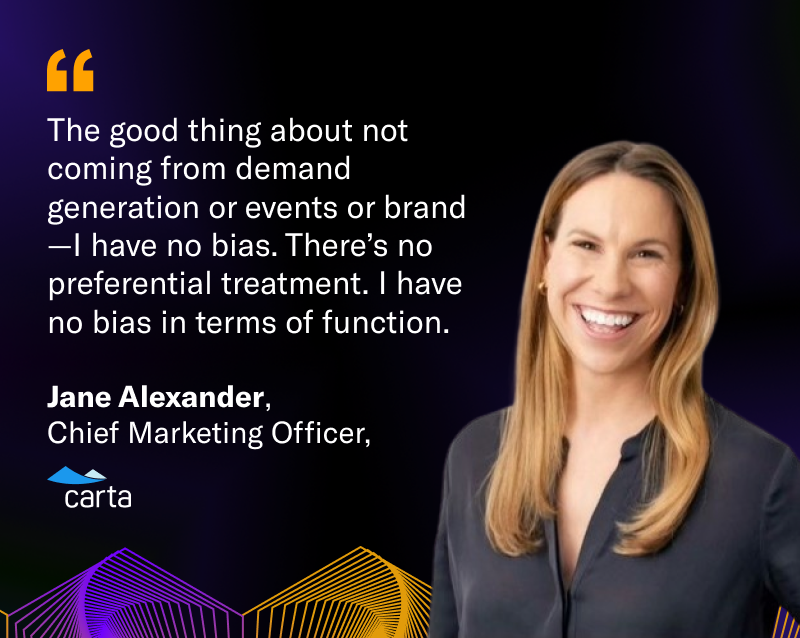Lessons from a Chief of Staff turned CMO: Meet Jane Alexander from Carta

Maximize Your Marketing ROI
Join 10,000 other marketers already getting the best tips on running engaging events that boost pipeline and create raving fans.
In the 14th episode of our CMO Diaries series, Kishore sat down with Jane Alexander, Chief Marketing Officer at Carta.
Carta is an ownership and equity management platform designed to help investors and companies manage cap tables, equity plans, valuations, and more. A true advocate for the community, Carta also offers resources for employees to help them better understand what it’s like to work at a startup and how to evaluate compensation and equity offers.
Jane joined us to chat about her surprising background (spoiler alert: it’s not marketing! 😯), what metrics drive sales and marketing success, how Carta thinks about events as part of the marketing mix, and, of course, Jane’s top book recommendations.
Below are a few highlights from Jane’s interview. Be sure to check out the full version for even more insight into Carta’s mission and how Jane approaches being CMO at a high-growth SaaS company in the startup space.

Welcome to CMO Diaries! Tell us more about Carta and what brought you to the company.
I was so excited to join Carta because of the mission. Private equity and ownership are the most powerful wealth creators that exist. And a lot of that return is coming from the private market, but not enough people have access. It’s a fraction of a fraction of a fraction, and if we can expand access to that—responsibly—if we can move the world just a little bit in that direction, we’re making a positive impact.
“If we accomplish just a little bit of what we set out to do at Carta, I think I’ll be really proud to have worked there.”
That was what brought me to Carta—but it’s the people that have kept me here. It’s a remarkable team full of passionate people who make work fun. I laugh a lot at work, which is always a good time.
You have a very interesting background—what have you learned so far about marketing?
Typically, people expect CMOs to have a marketing background, which makes sense! I didn’t come from that practice. I come from a sales and operations background.
So, I have to bring people in who do know marketing, who have that expertise, who are masters of their craft. I am really meticulous about bringing in people who are incredible at what they do. We’ve been so lucky to have people that are leading functions that are masters of their craft. They’ve done this for decades and can lead the team.

What I do have from the Chief of Staff world, my expertise, is that I am not going to teach you stuff you don’t know about marketing. What I can teach you—I know the soul of the company. If our job is to reveal who we are to the world, I’m really good at that. I have real context on the business and what we’re trying to do.
This is often a struggle with CMOs. You sometimes hear about friction with the CEO, but I don’t have that. I can give you the business vision. I can give you the space, the place, and the context for you to do what you do at a level and a playground that’s not that common.
Most marketers are focused on MQLs and driving new pipeline and revenue. Many don’t focus enough on customers adopting features to drive renewals and upsells. How does Carta approach this issue?
We do a thing at Carta that I really love. It’s a little non-traditional—we do a lot of things that are a little not traditional.
We are very problem oriented, regardless of what your role is or what your job at the company— your job is to solve the problem. When we think about the problems around adoption, retention, and cross-selling, we’ve got several folks at the company that are focused on it.
Our product managers are super focused on driving adoption. Our retention and renewals team on the sales side are super focused on adoption. And our product marketing managers, our demand generation team, and our brand team are really focused on it. So, we think about it in a couple different ways.
It’s really important for us, first and foremost, because we’re a SaaS business, so most of our revenue is going to come from expansion, upsell, renewal. Just getting a new logo is the tip of the iceberg.
We’re also starting to do a big cross-sell push at Carta. We now have multiple products to sell into our customer base. So, our product marketing team focuses on utilization, messaging, and finding the right segments of our customer base to adopt certain features.
We also have a team member who runs regressions. We look at every data point we can find and ask—what types of triggers, behaviors, or attributes lead someone to a behavior, like adopting a feature. And from there, how do we go five steps before that to lay out the red carpet to that behavior. We want to reduce as much friction as possible at every step.
“Our product marketing team’s motto is, ‘we help our product get to market and stay there.’”
It’s part of what they think about every single day. It’s not just about launches, it's not just getting stuff out there and landing new logos; it’s about keeping them in the market and maintaining that position.
What are some basic mistakes that early stage employees make when they join a company? What deeper questions should they ask?
I’ll share two mistakes that I made as an early employee at other companies.
The first is really understanding if you have access to early exercise. If you do and you believe in the company—just do it. It’s usually the cheapest moment. If you have the ability to exercise early, you can file an 83(b) election form with the IRS, which allows you to pay tax at the moment of purchase versus the moment of liquidation.
So, if your stock costs $5 a share and you pay $5 a share, there’s no tax due then. But let’s say you’re buying stock and your strike price is $5 a share, and over time the company grows in value and now the value of the stock is $7 a share. At the point of buying—even if you can’t use it, you can’t liquidate it, you can’t sell it—at the point of purchasing the equity, you owe tax on that $2. So, the longer you wait, the more of a tax bill you’re racking up in the interim.
Second, know what your post-termination exercise period is. When you leave a company, there’s a period of time where if you haven’t exercised your options you have only a window of time to do so. The standard is 90 days, some companies make it 30, and at Carta it’s as long as you’ve been at the company—so if you’ve been at the company for two years, you have two years to exercise your options. It’s an expensive mistake if you don’t know!
How does Carta think about field marketing and events as part of the larger marketing strategy?
Well, as you know, events have changed a lot in the past two years. For us, we’ve been doing two types of events.
The first is virtual. We have our big flagship event, Carta Equity Summit, which used to be in-person, but we moved it online during the pandemic. At first I was sad to not have that connection, but it was so powerful to have people logging in from all around the world. We had speakers that we couldn’t have had before because we didn’t have to fly people out. Last year we even had Serena Williams dialing in from her home office, which was so cool!

It will be, of course. Of course it will help us in the future. But, if we at all treat it like a lead gen event. If we email registrants about our products right away, we’re not just adding value to the ecosystem. So I think of events broadly about increasing value to the ecosystem and increasing consumer surplus. You have to trust that they will generate leads in the long-term, but that’s not the goal.
Our second set of events is also about really connecting. We do a series of small dinners with emerging fund managers. What we were hearing from this market is, “I just want to know what people are doing. I’m trying to start this fund, and I’m feeling very alone. Can I get some help?”
So, we sourced a few people from our team that know about these challenges to meet with 6-12 fund managers and let them all chat over dinner. When we started this, I was once again adamant—this is not a sales dinner; this is, “how do we share information?” It feels counterintuitive, but you have to see through the fog and believe that if I do the right thing, if I add value for the customer, it will come back to me.

What books do you think every marketer should read?
One book that I love is Different: Escaping the Competitive Herd by Youngme Moon. It’s about this concept of trying to be more and more of the same and take best practices - how can you be different? What are the ways you can stand out?
Also, When: The Scientific Secrets of Perfect Timing by Daniel Pink. It’s all about how when you do things matter just as much as what you do. For example, error rates for surgeons are much higher in afternoons versus mornings. The likelihood of getting parole from the same judge before lunch and after lunch is dramatically different.
It might sound crazy, but I religiously take breaks now. If part of my job is to make good decisions, be a good listener, and really understand people—all of the data shows that mental acuity with no breaks is way worse. So the moral of the story is to take breaks!

Transform Your Video Marketing with AI
Stay In Touch
Platform
Resources
© 2026 Copyright Goldcast, Inc. All rights reserved.





 Upcoming Events
Upcoming Events Event Series
Event Series On-Demand Events
On-Demand Events

